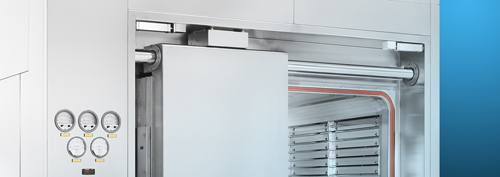Technological Solutions to Overcome the New Annex 1 Challenges
[Editor's Note: This article was written prior to publication of the final Annex 1 document in August 2022.]
 Photo of an isolator Magnetodoor® courtesy of De Lama, S.p.A.
Photo of an isolator Magnetodoor® courtesy of De Lama, S.p.A.
One indication of the impact is the size of the document, which has grown from 16 pages (2008) to 57 pages (2022). Beyond the increase in volume is the paradigm shift in the title itself, from the “Manufacture of sterile medicines” to the “Manufacture of sterile products.” The focus of the Annex has become broader and much more generic, significantly increasing its impact.
In expanding the focus from sterile medicines to sterile products, the scope of its application moves beyond the standard to encompass active substances, sterile excipients, primary packaging materials and finished dosage forms. It also affects applied technologies and processes—from manual to highly automated—to the production of "small molecules" and biotechnological products.
As we cannot review all the innovations and challenges launched by the new Annex 1 in this article, we have focused on one of the epochal innovations it brings with it: barrier technology.
What Annex 1 Says about Barrier Technologies
Paragraphs 4.3, 4.18 and 4.19 of Annex 1 specifically address isolators and restricted access barrier systems (RABS) (1). What emerges is that not only are barrier technologies strongly recommended, but the Annex goes so far as stating that any choice that does not involve RABS or isolators must be justified. In effect, there is practically an obligation to use isolators or RABS unless their use takes place for reasons of “force majeure,” which in any case must be justified.
Other relevant concepts that emerge from these three paragraphs are the design and associated processes of the isolators and RABS, which must ensure maximum protection of Grade A areas. As the transfer of materials in and out of the isolator is a major source of contamination, the entry of additional materials following sterilization of the RABS should be minimized. And any activity that may compromise the safety of the critical area that cannot be eliminated should be evaluated and subjected to checks.
In light of these considerations, how is it possible to carry out traditional washing and sterilization processes of items that must enter or exit the isolator, avoiding contamination? Annex 1 clearly highlights the risk.
Decontamination carried out inside the isolator is not comparable to real sterilization. At environmental pressure, the sterilizing agent, hydrogen peroxide, is unable to penetrate complex geometries, cavities, sub-squares or the “covered” parts with the sole action vaporization generates. That includes not only both parts of the filling line under the isolator—contact and noncontact product parts—but also components of the final product itself, such as caps, vials and syringes.
Traditional sterilization processes that require a transfer into and out of the isolator via rapid transfer ports (RPT) or laminar flow trolleys and involve the use of Tyvek® bags are extremely laborious, expensive and wasteful. Even their dimensional limits (e.g., RTPs typically reach a maximum diameter of 50 cm) could generate a risk of contamination.
Are there any solutions to overcome these problems?
The simple answer is yes. By employing a combination of three currently marketed technologies, a firm can achieve the maximum benefit of overcoming contamination issues:
- Direct connection of sterilization and/or washing equipment to the isolator through a magnetized door can create a single, extended Class A environment
- Hydrogen peroxide sterilization technology under high vacuum and zero air allows sterilization of nonthermosensitive parts as well as thermosensitive parts that are not treatable with thermal processes (e.g., saturated steam sterilization is not compatible with parts of the filling line composed of plastic materials derived from POM-C, as the heat would deform them)
- Combining multiple technologies into one single piece of equipment (i.e., sterilization, decontamination and washing) minimizes the impact of the layout and space of the isolator itself, without the need for space to open doors of the sterilization/washing unit
The use of a magnetic door provides a number of advantages. As it opens horizontally, like a sliding door, it reduces the amount of space needed inside the isolator. Without the plastic belts that are incompatible with hydrogen peroxide, it can also be completely sanitized during normal decontamination cycles and can be kept in motion (opening and closing) during the same cycles. The insulation in the magnetic door is adequate to ensure a “thermal break” without affecting the temperature of the isolator. In fact, some couplings of depyrogenation ovens have already been created to sterilize empty aluminum cans before their introduction into the isolator for subsequent filling with API powders, and the temperature (250 ºC) operated by the dry-heat sterilizer coupled to the isolator did not affect the environment of the isolator itself. And, because the magnetic door slides horizontally, without relying on gear wheels and pulleys, it does not present a risk of particulate release inside the isolator.
Hydrogen-peroxide sterilization technology does not use the classic technology of vaporized hydrogen peroxide for decontamination, or “surface sterilization” as it is sometimes called. Instead, once the product has been introduced inside the unit, the low temperature of the process allows sterilization of the thermosensitive parts of the isolator. It also reaches components with complex cavities and geometries and can penetrate Tyvek® bags containing caps or nests of syringes or tubes sealed with Tyvek® or medical paper. Components may be introduced for subsequent filling under the isolator, or they can be sterilized in the unit connected to the entrance of the isolator (“entry deck”) before the operation to be carried out with the filling line.
Using the combined technology—sterilization, decontamination and washing technologies—as a single unit can transform an autoclave into a multipurpose unit at the service of the isolator, useful for washing and then sterilizing pieces of the isolator filling line before or after their use.
The direct connection generates an aseptic environment aligned with Grade A requirements, creating an extension of a Class A area that embraces the sterilization and/or washing unit connected to the isolator itself. In this way, a radical solution to the critical issues posed by Annex 1, that is, the risk of contamination, is obtained.
The positioning of these washing–sterilization units, depending on the specific needs of the workflow, can serve as:
- “Entry deck” to sterilize or wash items before they enter the isolator
- “Exit deck,” for example, for the terminal sterilization of syringes filled aseptically in countries where terminal sterilization is required by law
- “Service peninsula,” equipped with a double-magnetized door, ideally placed on the side of the isolator, to create a multiuse through-chamber that can both wash and sterilize the parts of the isolator (e.g., parts that require a format change) as well as act as a useful unit to carry out the operations in the entry and exit decks
These solutions, used in combination, allow progression to the root of the cross-contamination issue raised by Annex 1 and can eliminate these criticalities without compromise, giving life to a leaner, faster and safer workflow.
References
- European Commission. Annex 1: Manufacture of Sterile Products (Draft). EudraLex – Volume 4 – Good Manufacturing Practice for Medicinal Products for Human and Veterinary Use; European Commission: Brussels, 2020.



 Marco Bianchi, Marketing, Communications & Sales Manager of De Lama, S.p.A., is responsible for the all the company’s communications–paper, video and digital–as well as its social media. He also scouts for De Lama’s international agents and maintains the company network. Bianchi joined De Lama, his family’s company business, in 2018 after working in the world of e-commerce and digital publishing. His interest in journalism and communications began at the Universita de Pavia, where he earned his law degree and served as editorial director of the magazine he founded, Wait. Bianchi's interests broadened to encompass the digital world, search engine optimization and web marketing he employs in his current role with De Lama.
Marco Bianchi, Marketing, Communications & Sales Manager of De Lama, S.p.A., is responsible for the all the company’s communications–paper, video and digital–as well as its social media. He also scouts for De Lama’s international agents and maintains the company network. Bianchi joined De Lama, his family’s company business, in 2018 after working in the world of e-commerce and digital publishing. His interest in journalism and communications began at the Universita de Pavia, where he earned his law degree and served as editorial director of the magazine he founded, Wait. Bianchi's interests broadened to encompass the digital world, search engine optimization and web marketing he employs in his current role with De Lama.